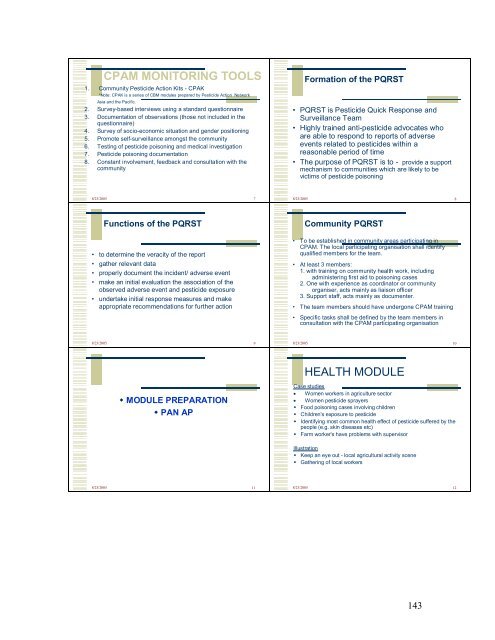Tanzania Multi Stakeholder Map - WebNG
Tanzania Multi Stakeholder Map - WebNG
Tanzania Multi Stakeholder Map - WebNG
You also want an ePaper? Increase the reach of your titles
YUMPU automatically turns print PDFs into web optimized ePapers that Google loves.
CPAM MONITORING TOOLS<br />
1. Community Pesticide Action Kits - CPAK<br />
*Note: CPAK is a series of CBM modules prepared by Pesticide Action Network<br />
Asia and the Pacific.<br />
2. Survey-based interviews using a standard questionnaire<br />
3. Documentation of observations (those not included in the<br />
questionnaire)<br />
4. Survey of socio-economic situation and gender positioning<br />
5. Promote self-surveillance amongst the community<br />
6. Testing of pesticide poisoning and medical investigation<br />
7. Pesticide poisoning documentation<br />
8. Constant involvement, feedback and consultation with the<br />
community<br />
Formation of the PQRST<br />
• PQRST is Pesticide Quick Response and<br />
Surveillance Team<br />
• Highly trained anti-pesticide advocates who<br />
are able to respond to reports of adverse<br />
events related to pesticides within a<br />
reasonable period of time<br />
• The purpose of PQRST is to - provide a support<br />
mechanism to communities which are likely to be<br />
victims of pesticide poisoning<br />
8/23/2005 7<br />
8/23/2005 8<br />
Functions of the PQRST<br />
• to determine the veracity of the report<br />
• gather relevant data<br />
• properly document the incident/ adverse event<br />
• make an initial evaluation the association of the<br />
observed adverse event and pesticide exposure<br />
• undertake initial response measures and make<br />
appropriate recommendations for further action<br />
Community PQRST<br />
• To be established in community areas participating in<br />
CPAM. The local participating organisation shall identify<br />
qualified members for the team.<br />
• At least 3 members:<br />
1. with training on community health work, including<br />
administering first aid to poisoning cases<br />
2. One with experience as coordinator or community<br />
organiser, acts mainly as liaison officer<br />
3. Support staff, acts mainly as documenter.<br />
• The team members should have undergone CPAM training<br />
• Specific tasks shall be defined by the team members in<br />
consultation with the CPAM participating organisation<br />
8/23/2005 9<br />
8/23/2005 10<br />
HEALTH MODULE<br />
• MODULE PREPARATION<br />
• PAN AP<br />
Case studies<br />
• Women workers in agriculture sector<br />
• Women pesticide sprayers<br />
• Food poisoning cases involving children<br />
• Children's exposure to pesticide<br />
• Identifying most common health effect of pesticide suffered by the<br />
people (e.g. skin diseases etc)<br />
• Farm worker's have problems with supervisor<br />
Illustration<br />
• Keep an eye out - local agricultural activity scene<br />
• Gathering of local workers<br />
8/23/2005 11<br />
8/23/2005 12<br />
143
















